Organisational Behaviour: Employee Satisfaction and Company Growth
VerifiedAdded on 2020/04/07
|10
|2152
|46
Essay
AI Summary
This essay delves into the critical aspects of organisational behaviour, emphasising the significance of understanding employee attitude, job satisfaction, and commitment in enhancing workplace productivity and overall company growth. It examines how management policies can influence employee behaviour, fostering a positive work environment and boosting motivation. The essay analyses various theories, including Maslow's Hierarchy of Needs and Herzberg's Motivator-Hygiene Theory, to provide insights into meeting employee needs and addressing factors that contribute to both satisfaction and dissatisfaction. Furthermore, it highlights the impact of positive and negative attitudes, the importance of mutual trust between employers and employees, and the role of humour in establishing a positive organisational culture. The essay concludes that a proactive approach to managing organisational behaviour, through effective communication, conflict resolution, and the implementation of appropriate rewards and incentives, is essential for achieving a highly committed and productive workforce, ultimately driving organisational success. Desklib provides a platform for students to access this and many other solved assignments.
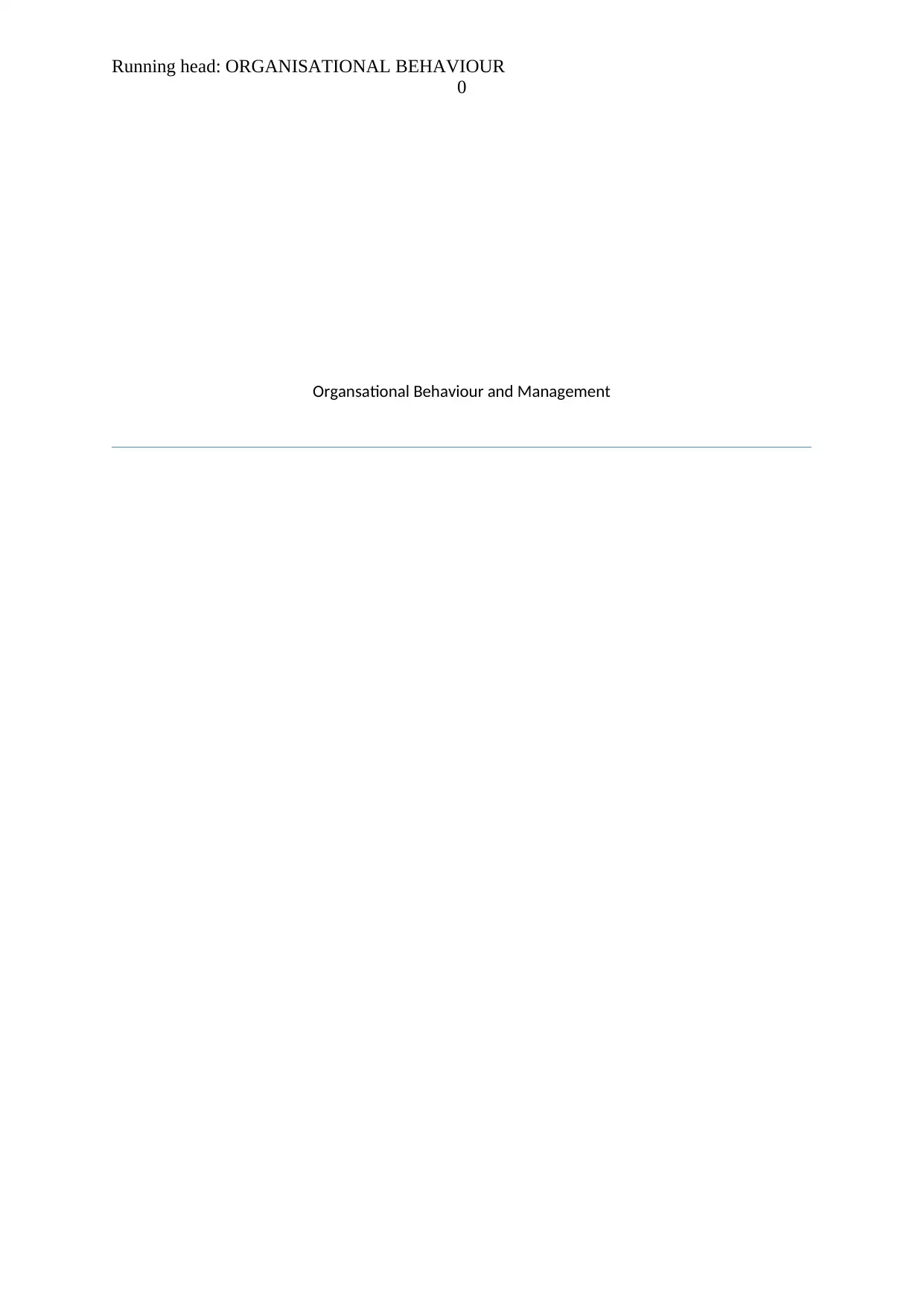
Running head: ORGANISATIONAL BEHAVIOUR
0
Organsational Behaviour and Management
0
Organsational Behaviour and Management
Paraphrase This Document
Need a fresh take? Get an instant paraphrase of this document with our AI Paraphraser

ORGANISATIONAL BEHAVIOUR 1
Contents
Introduction................................................................................................................................2
Organisational Behaviour and Job Satisfaction.........................................................................3
Conclusion..................................................................................................................................7
References..................................................................................................................................8
Contents
Introduction................................................................................................................................2
Organisational Behaviour and Job Satisfaction.........................................................................3
Conclusion..................................................................................................................................7
References..................................................................................................................................8
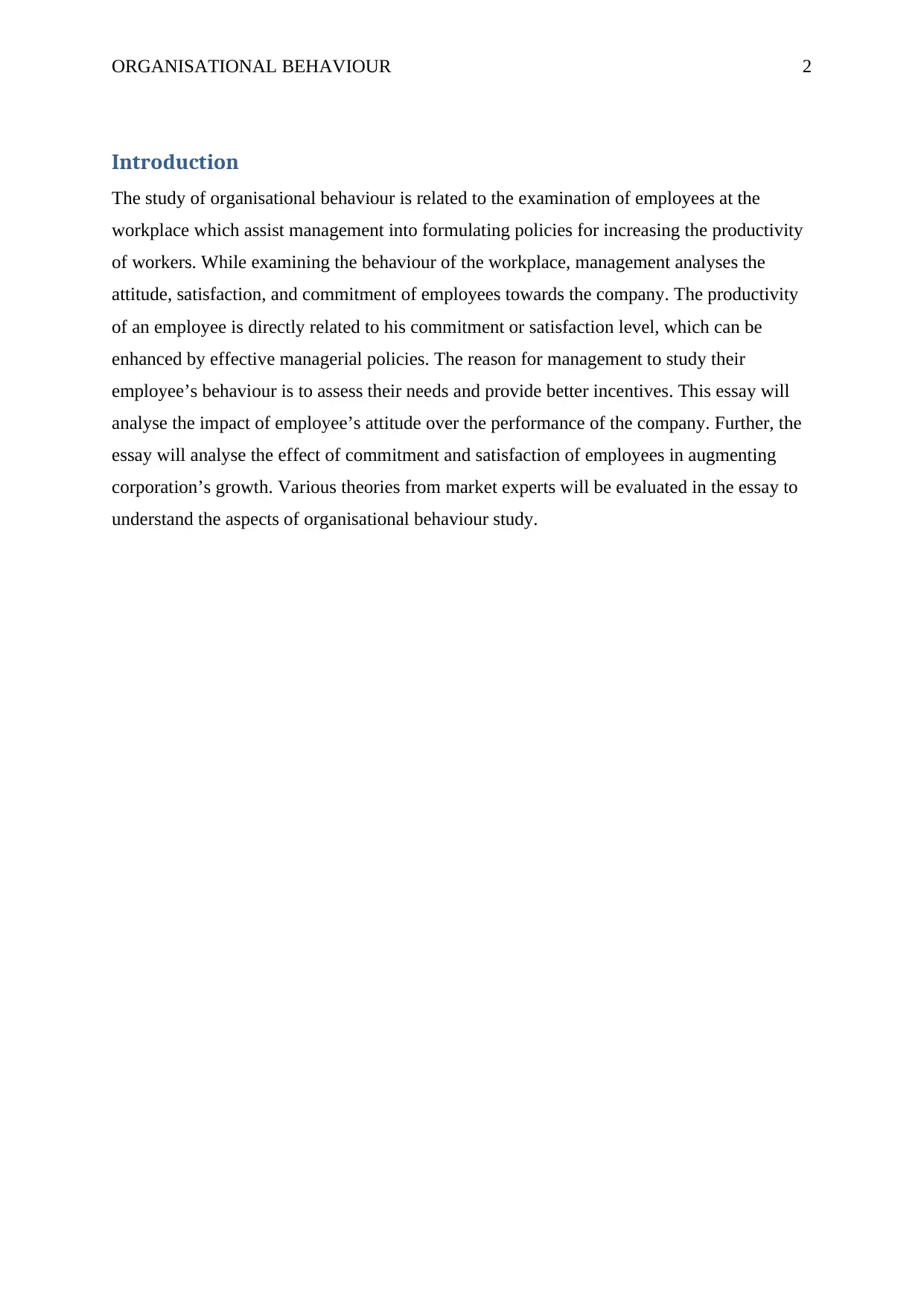
ORGANISATIONAL BEHAVIOUR 2
Introduction
The study of organisational behaviour is related to the examination of employees at the
workplace which assist management into formulating policies for increasing the productivity
of workers. While examining the behaviour of the workplace, management analyses the
attitude, satisfaction, and commitment of employees towards the company. The productivity
of an employee is directly related to his commitment or satisfaction level, which can be
enhanced by effective managerial policies. The reason for management to study their
employee’s behaviour is to assess their needs and provide better incentives. This essay will
analyse the impact of employee’s attitude over the performance of the company. Further, the
essay will analyse the effect of commitment and satisfaction of employees in augmenting
corporation’s growth. Various theories from market experts will be evaluated in the essay to
understand the aspects of organisational behaviour study.
Introduction
The study of organisational behaviour is related to the examination of employees at the
workplace which assist management into formulating policies for increasing the productivity
of workers. While examining the behaviour of the workplace, management analyses the
attitude, satisfaction, and commitment of employees towards the company. The productivity
of an employee is directly related to his commitment or satisfaction level, which can be
enhanced by effective managerial policies. The reason for management to study their
employee’s behaviour is to assess their needs and provide better incentives. This essay will
analyse the impact of employee’s attitude over the performance of the company. Further, the
essay will analyse the effect of commitment and satisfaction of employees in augmenting
corporation’s growth. Various theories from market experts will be evaluated in the essay to
understand the aspects of organisational behaviour study.
⊘ This is a preview!⊘
Do you want full access?
Subscribe today to unlock all pages.

Trusted by 1+ million students worldwide
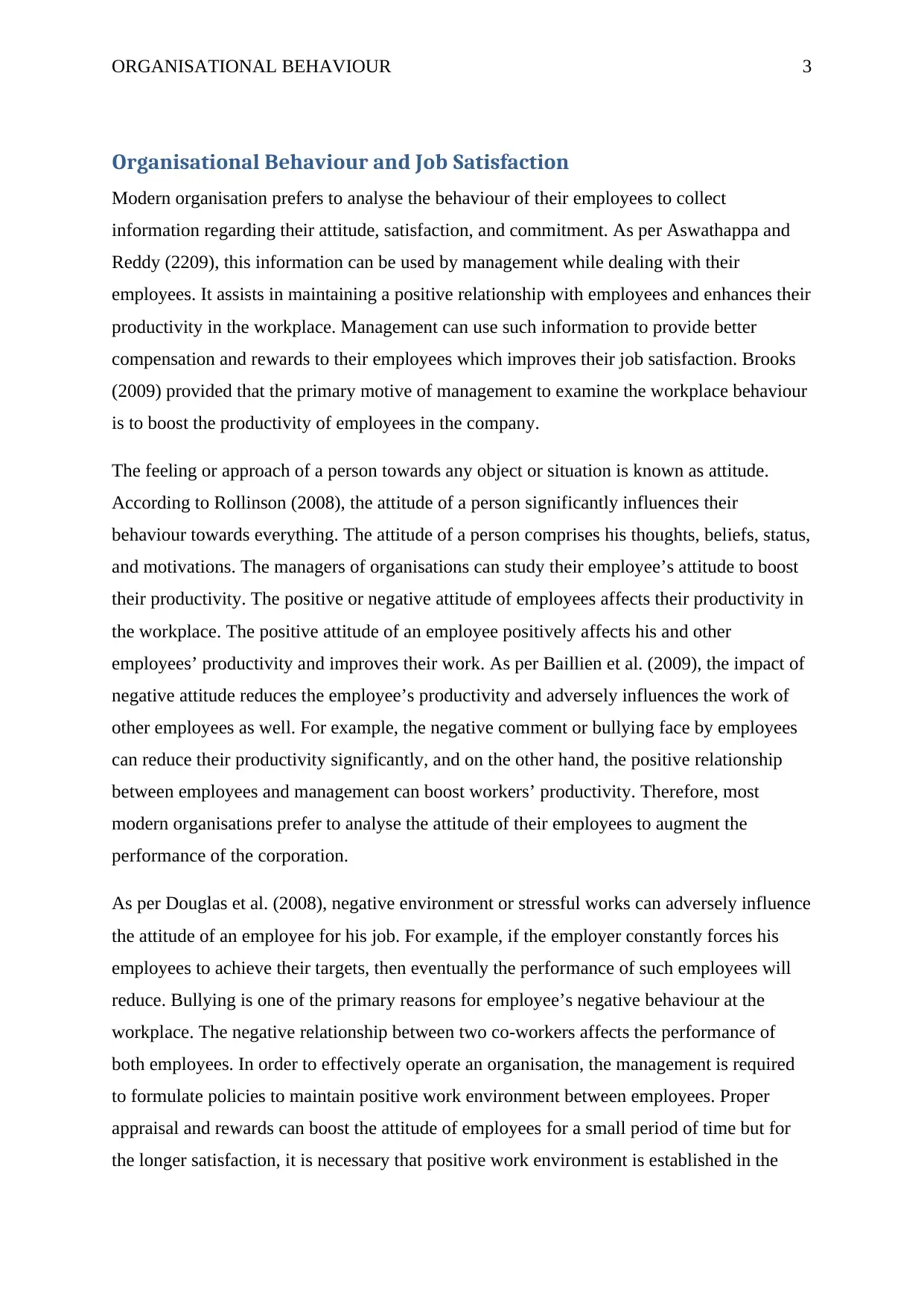
ORGANISATIONAL BEHAVIOUR 3
Organisational Behaviour and Job Satisfaction
Modern organisation prefers to analyse the behaviour of their employees to collect
information regarding their attitude, satisfaction, and commitment. As per Aswathappa and
Reddy (2209), this information can be used by management while dealing with their
employees. It assists in maintaining a positive relationship with employees and enhances their
productivity in the workplace. Management can use such information to provide better
compensation and rewards to their employees which improves their job satisfaction. Brooks
(2009) provided that the primary motive of management to examine the workplace behaviour
is to boost the productivity of employees in the company.
The feeling or approach of a person towards any object or situation is known as attitude.
According to Rollinson (2008), the attitude of a person significantly influences their
behaviour towards everything. The attitude of a person comprises his thoughts, beliefs, status,
and motivations. The managers of organisations can study their employee’s attitude to boost
their productivity. The positive or negative attitude of employees affects their productivity in
the workplace. The positive attitude of an employee positively affects his and other
employees’ productivity and improves their work. As per Baillien et al. (2009), the impact of
negative attitude reduces the employee’s productivity and adversely influences the work of
other employees as well. For example, the negative comment or bullying face by employees
can reduce their productivity significantly, and on the other hand, the positive relationship
between employees and management can boost workers’ productivity. Therefore, most
modern organisations prefer to analyse the attitude of their employees to augment the
performance of the corporation.
As per Douglas et al. (2008), negative environment or stressful works can adversely influence
the attitude of an employee for his job. For example, if the employer constantly forces his
employees to achieve their targets, then eventually the performance of such employees will
reduce. Bullying is one of the primary reasons for employee’s negative behaviour at the
workplace. The negative relationship between two co-workers affects the performance of
both employees. In order to effectively operate an organisation, the management is required
to formulate policies to maintain positive work environment between employees. Proper
appraisal and rewards can boost the attitude of employees for a small period of time but for
the longer satisfaction, it is necessary that positive work environment is established in the
Organisational Behaviour and Job Satisfaction
Modern organisation prefers to analyse the behaviour of their employees to collect
information regarding their attitude, satisfaction, and commitment. As per Aswathappa and
Reddy (2209), this information can be used by management while dealing with their
employees. It assists in maintaining a positive relationship with employees and enhances their
productivity in the workplace. Management can use such information to provide better
compensation and rewards to their employees which improves their job satisfaction. Brooks
(2009) provided that the primary motive of management to examine the workplace behaviour
is to boost the productivity of employees in the company.
The feeling or approach of a person towards any object or situation is known as attitude.
According to Rollinson (2008), the attitude of a person significantly influences their
behaviour towards everything. The attitude of a person comprises his thoughts, beliefs, status,
and motivations. The managers of organisations can study their employee’s attitude to boost
their productivity. The positive or negative attitude of employees affects their productivity in
the workplace. The positive attitude of an employee positively affects his and other
employees’ productivity and improves their work. As per Baillien et al. (2009), the impact of
negative attitude reduces the employee’s productivity and adversely influences the work of
other employees as well. For example, the negative comment or bullying face by employees
can reduce their productivity significantly, and on the other hand, the positive relationship
between employees and management can boost workers’ productivity. Therefore, most
modern organisations prefer to analyse the attitude of their employees to augment the
performance of the corporation.
As per Douglas et al. (2008), negative environment or stressful works can adversely influence
the attitude of an employee for his job. For example, if the employer constantly forces his
employees to achieve their targets, then eventually the performance of such employees will
reduce. Bullying is one of the primary reasons for employee’s negative behaviour at the
workplace. The negative relationship between two co-workers affects the performance of
both employees. In order to effectively operate an organisation, the management is required
to formulate policies to maintain positive work environment between employees. Proper
appraisal and rewards can boost the attitude of employees for a small period of time but for
the longer satisfaction, it is necessary that positive work environment is established in the
Paraphrase This Document
Need a fresh take? Get an instant paraphrase of this document with our AI Paraphraser
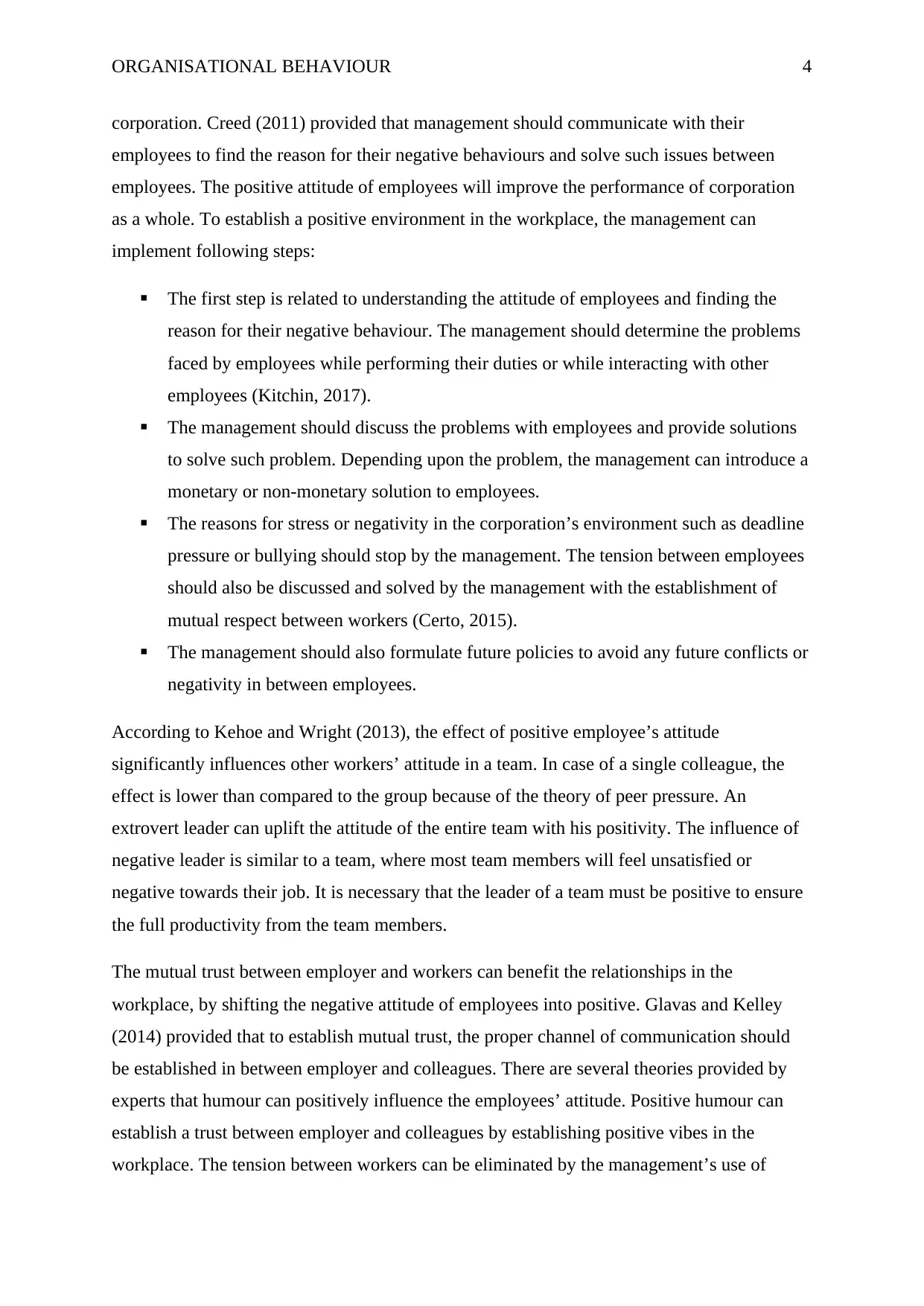
ORGANISATIONAL BEHAVIOUR 4
corporation. Creed (2011) provided that management should communicate with their
employees to find the reason for their negative behaviours and solve such issues between
employees. The positive attitude of employees will improve the performance of corporation
as a whole. To establish a positive environment in the workplace, the management can
implement following steps:
The first step is related to understanding the attitude of employees and finding the
reason for their negative behaviour. The management should determine the problems
faced by employees while performing their duties or while interacting with other
employees (Kitchin, 2017).
The management should discuss the problems with employees and provide solutions
to solve such problem. Depending upon the problem, the management can introduce a
monetary or non-monetary solution to employees.
The reasons for stress or negativity in the corporation’s environment such as deadline
pressure or bullying should stop by the management. The tension between employees
should also be discussed and solved by the management with the establishment of
mutual respect between workers (Certo, 2015).
The management should also formulate future policies to avoid any future conflicts or
negativity in between employees.
According to Kehoe and Wright (2013), the effect of positive employee’s attitude
significantly influences other workers’ attitude in a team. In case of a single colleague, the
effect is lower than compared to the group because of the theory of peer pressure. An
extrovert leader can uplift the attitude of the entire team with his positivity. The influence of
negative leader is similar to a team, where most team members will feel unsatisfied or
negative towards their job. It is necessary that the leader of a team must be positive to ensure
the full productivity from the team members.
The mutual trust between employer and workers can benefit the relationships in the
workplace, by shifting the negative attitude of employees into positive. Glavas and Kelley
(2014) provided that to establish mutual trust, the proper channel of communication should
be established in between employer and colleagues. There are several theories provided by
experts that humour can positively influence the employees’ attitude. Positive humour can
establish a trust between employer and colleagues by establishing positive vibes in the
workplace. The tension between workers can be eliminated by the management’s use of
corporation. Creed (2011) provided that management should communicate with their
employees to find the reason for their negative behaviours and solve such issues between
employees. The positive attitude of employees will improve the performance of corporation
as a whole. To establish a positive environment in the workplace, the management can
implement following steps:
The first step is related to understanding the attitude of employees and finding the
reason for their negative behaviour. The management should determine the problems
faced by employees while performing their duties or while interacting with other
employees (Kitchin, 2017).
The management should discuss the problems with employees and provide solutions
to solve such problem. Depending upon the problem, the management can introduce a
monetary or non-monetary solution to employees.
The reasons for stress or negativity in the corporation’s environment such as deadline
pressure or bullying should stop by the management. The tension between employees
should also be discussed and solved by the management with the establishment of
mutual respect between workers (Certo, 2015).
The management should also formulate future policies to avoid any future conflicts or
negativity in between employees.
According to Kehoe and Wright (2013), the effect of positive employee’s attitude
significantly influences other workers’ attitude in a team. In case of a single colleague, the
effect is lower than compared to the group because of the theory of peer pressure. An
extrovert leader can uplift the attitude of the entire team with his positivity. The influence of
negative leader is similar to a team, where most team members will feel unsatisfied or
negative towards their job. It is necessary that the leader of a team must be positive to ensure
the full productivity from the team members.
The mutual trust between employer and workers can benefit the relationships in the
workplace, by shifting the negative attitude of employees into positive. Glavas and Kelley
(2014) provided that to establish mutual trust, the proper channel of communication should
be established in between employer and colleagues. There are several theories provided by
experts that humour can positively influence the employees’ attitude. Positive humour can
establish a trust between employer and colleagues by establishing positive vibes in the
workplace. The tension between workers can be eliminated by the management’s use of
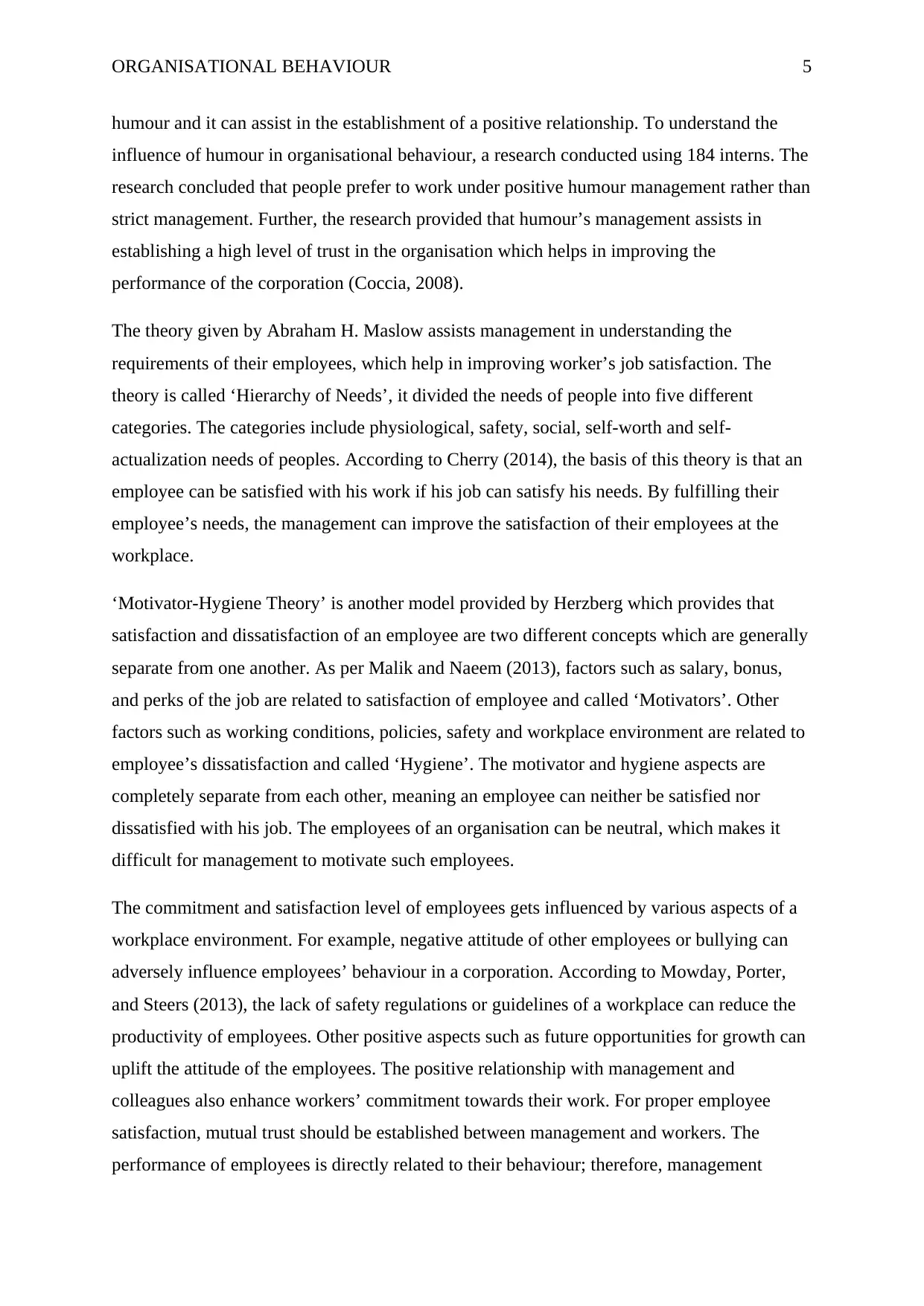
ORGANISATIONAL BEHAVIOUR 5
humour and it can assist in the establishment of a positive relationship. To understand the
influence of humour in organisational behaviour, a research conducted using 184 interns. The
research concluded that people prefer to work under positive humour management rather than
strict management. Further, the research provided that humour’s management assists in
establishing a high level of trust in the organisation which helps in improving the
performance of the corporation (Coccia, 2008).
The theory given by Abraham H. Maslow assists management in understanding the
requirements of their employees, which help in improving worker’s job satisfaction. The
theory is called ‘Hierarchy of Needs’, it divided the needs of people into five different
categories. The categories include physiological, safety, social, self-worth and self-
actualization needs of peoples. According to Cherry (2014), the basis of this theory is that an
employee can be satisfied with his work if his job can satisfy his needs. By fulfilling their
employee’s needs, the management can improve the satisfaction of their employees at the
workplace.
‘Motivator-Hygiene Theory’ is another model provided by Herzberg which provides that
satisfaction and dissatisfaction of an employee are two different concepts which are generally
separate from one another. As per Malik and Naeem (2013), factors such as salary, bonus,
and perks of the job are related to satisfaction of employee and called ‘Motivators’. Other
factors such as working conditions, policies, safety and workplace environment are related to
employee’s dissatisfaction and called ‘Hygiene’. The motivator and hygiene aspects are
completely separate from each other, meaning an employee can neither be satisfied nor
dissatisfied with his job. The employees of an organisation can be neutral, which makes it
difficult for management to motivate such employees.
The commitment and satisfaction level of employees gets influenced by various aspects of a
workplace environment. For example, negative attitude of other employees or bullying can
adversely influence employees’ behaviour in a corporation. According to Mowday, Porter,
and Steers (2013), the lack of safety regulations or guidelines of a workplace can reduce the
productivity of employees. Other positive aspects such as future opportunities for growth can
uplift the attitude of the employees. The positive relationship with management and
colleagues also enhance workers’ commitment towards their work. For proper employee
satisfaction, mutual trust should be established between management and workers. The
performance of employees is directly related to their behaviour; therefore, management
humour and it can assist in the establishment of a positive relationship. To understand the
influence of humour in organisational behaviour, a research conducted using 184 interns. The
research concluded that people prefer to work under positive humour management rather than
strict management. Further, the research provided that humour’s management assists in
establishing a high level of trust in the organisation which helps in improving the
performance of the corporation (Coccia, 2008).
The theory given by Abraham H. Maslow assists management in understanding the
requirements of their employees, which help in improving worker’s job satisfaction. The
theory is called ‘Hierarchy of Needs’, it divided the needs of people into five different
categories. The categories include physiological, safety, social, self-worth and self-
actualization needs of peoples. According to Cherry (2014), the basis of this theory is that an
employee can be satisfied with his work if his job can satisfy his needs. By fulfilling their
employee’s needs, the management can improve the satisfaction of their employees at the
workplace.
‘Motivator-Hygiene Theory’ is another model provided by Herzberg which provides that
satisfaction and dissatisfaction of an employee are two different concepts which are generally
separate from one another. As per Malik and Naeem (2013), factors such as salary, bonus,
and perks of the job are related to satisfaction of employee and called ‘Motivators’. Other
factors such as working conditions, policies, safety and workplace environment are related to
employee’s dissatisfaction and called ‘Hygiene’. The motivator and hygiene aspects are
completely separate from each other, meaning an employee can neither be satisfied nor
dissatisfied with his job. The employees of an organisation can be neutral, which makes it
difficult for management to motivate such employees.
The commitment and satisfaction level of employees gets influenced by various aspects of a
workplace environment. For example, negative attitude of other employees or bullying can
adversely influence employees’ behaviour in a corporation. According to Mowday, Porter,
and Steers (2013), the lack of safety regulations or guidelines of a workplace can reduce the
productivity of employees. Other positive aspects such as future opportunities for growth can
uplift the attitude of the employees. The positive relationship with management and
colleagues also enhance workers’ commitment towards their work. For proper employee
satisfaction, mutual trust should be established between management and workers. The
performance of employees is directly related to their behaviour; therefore, management
⊘ This is a preview!⊘
Do you want full access?
Subscribe today to unlock all pages.

Trusted by 1+ million students worldwide
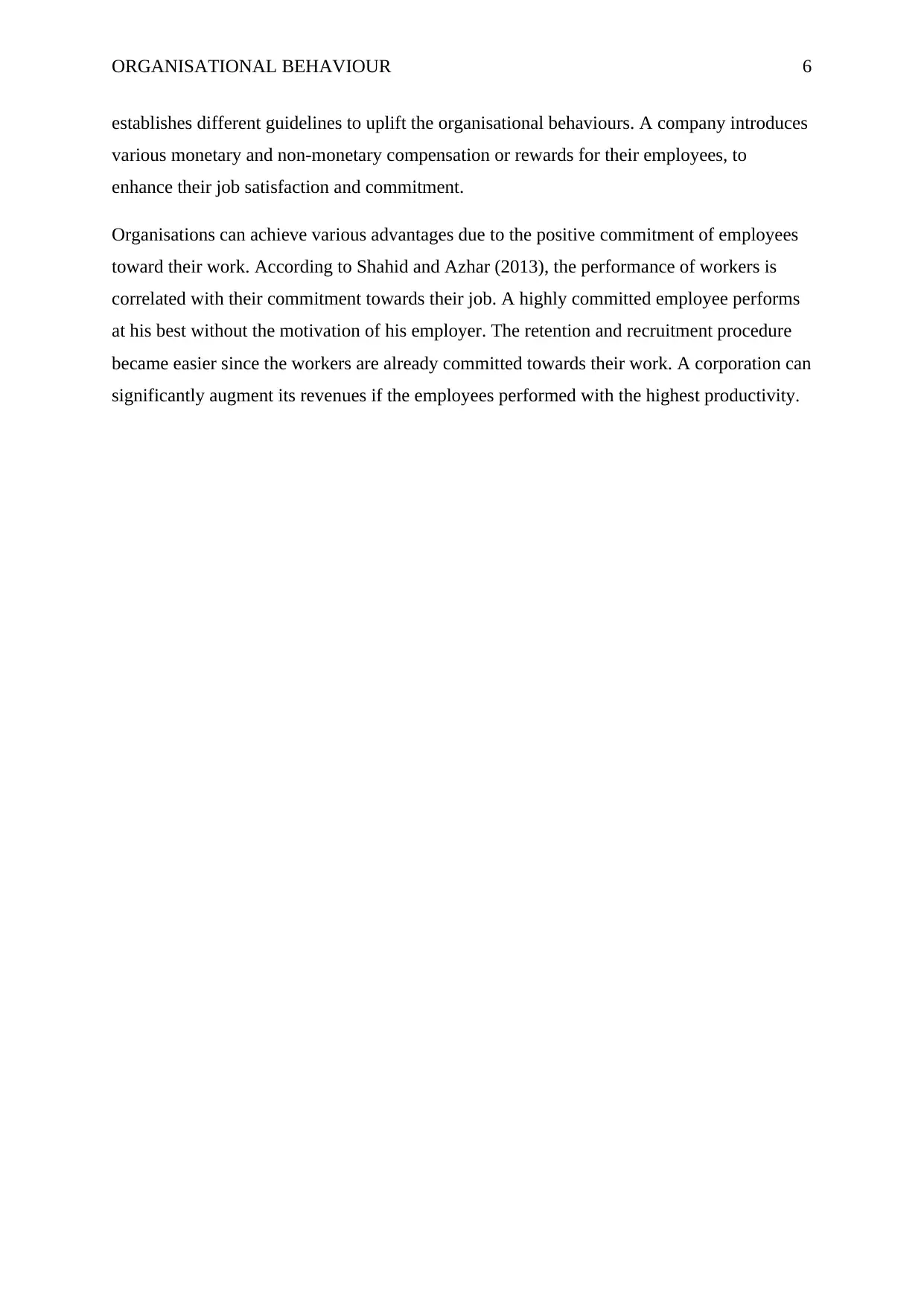
ORGANISATIONAL BEHAVIOUR 6
establishes different guidelines to uplift the organisational behaviours. A company introduces
various monetary and non-monetary compensation or rewards for their employees, to
enhance their job satisfaction and commitment.
Organisations can achieve various advantages due to the positive commitment of employees
toward their work. According to Shahid and Azhar (2013), the performance of workers is
correlated with their commitment towards their job. A highly committed employee performs
at his best without the motivation of his employer. The retention and recruitment procedure
became easier since the workers are already committed towards their work. A corporation can
significantly augment its revenues if the employees performed with the highest productivity.
establishes different guidelines to uplift the organisational behaviours. A company introduces
various monetary and non-monetary compensation or rewards for their employees, to
enhance their job satisfaction and commitment.
Organisations can achieve various advantages due to the positive commitment of employees
toward their work. According to Shahid and Azhar (2013), the performance of workers is
correlated with their commitment towards their job. A highly committed employee performs
at his best without the motivation of his employer. The retention and recruitment procedure
became easier since the workers are already committed towards their work. A corporation can
significantly augment its revenues if the employees performed with the highest productivity.
Paraphrase This Document
Need a fresh take? Get an instant paraphrase of this document with our AI Paraphraser
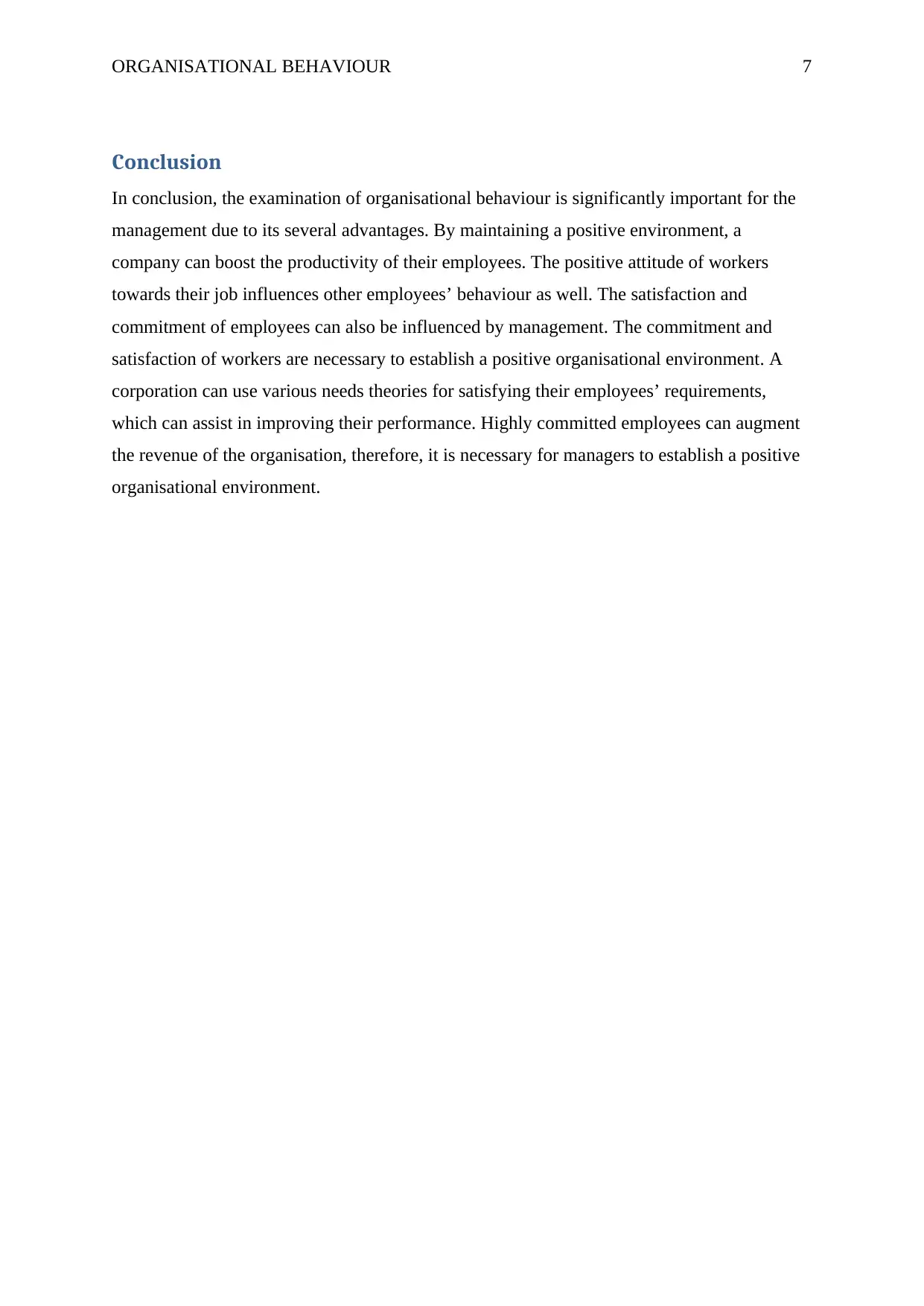
ORGANISATIONAL BEHAVIOUR 7
Conclusion
In conclusion, the examination of organisational behaviour is significantly important for the
management due to its several advantages. By maintaining a positive environment, a
company can boost the productivity of their employees. The positive attitude of workers
towards their job influences other employees’ behaviour as well. The satisfaction and
commitment of employees can also be influenced by management. The commitment and
satisfaction of workers are necessary to establish a positive organisational environment. A
corporation can use various needs theories for satisfying their employees’ requirements,
which can assist in improving their performance. Highly committed employees can augment
the revenue of the organisation, therefore, it is necessary for managers to establish a positive
organisational environment.
Conclusion
In conclusion, the examination of organisational behaviour is significantly important for the
management due to its several advantages. By maintaining a positive environment, a
company can boost the productivity of their employees. The positive attitude of workers
towards their job influences other employees’ behaviour as well. The satisfaction and
commitment of employees can also be influenced by management. The commitment and
satisfaction of workers are necessary to establish a positive organisational environment. A
corporation can use various needs theories for satisfying their employees’ requirements,
which can assist in improving their performance. Highly committed employees can augment
the revenue of the organisation, therefore, it is necessary for managers to establish a positive
organisational environment.
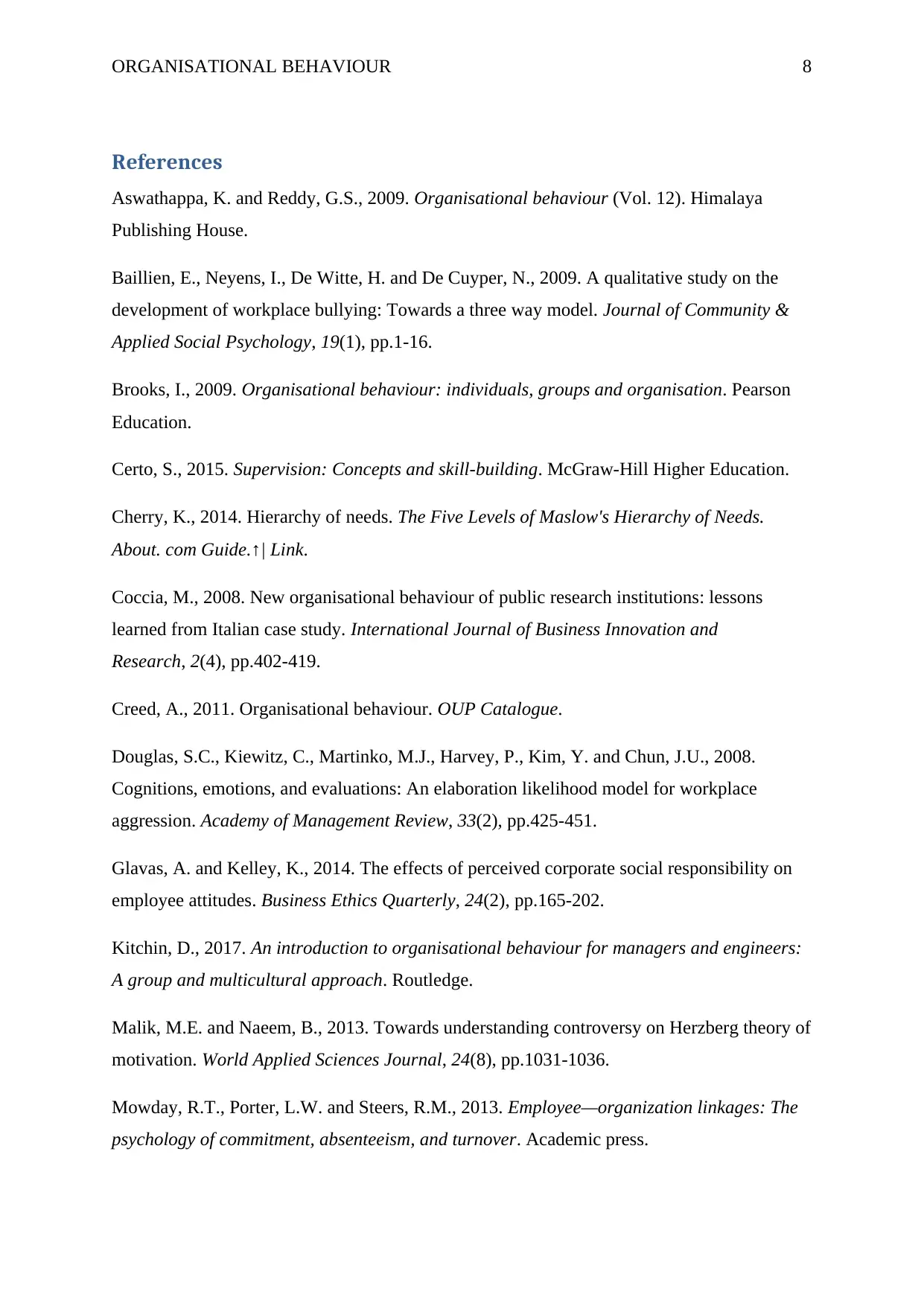
ORGANISATIONAL BEHAVIOUR 8
References
Aswathappa, K. and Reddy, G.S., 2009. Organisational behaviour (Vol. 12). Himalaya
Publishing House.
Baillien, E., Neyens, I., De Witte, H. and De Cuyper, N., 2009. A qualitative study on the
development of workplace bullying: Towards a three way model. Journal of Community &
Applied Social Psychology, 19(1), pp.1-16.
Brooks, I., 2009. Organisational behaviour: individuals, groups and organisation. Pearson
Education.
Certo, S., 2015. Supervision: Concepts and skill-building. McGraw-Hill Higher Education.
Cherry, K., 2014. Hierarchy of needs. The Five Levels of Maslow's Hierarchy of Needs.
About. com Guide.↑| Link.
Coccia, M., 2008. New organisational behaviour of public research institutions: lessons
learned from Italian case study. International Journal of Business Innovation and
Research, 2(4), pp.402-419.
Creed, A., 2011. Organisational behaviour. OUP Catalogue.
Douglas, S.C., Kiewitz, C., Martinko, M.J., Harvey, P., Kim, Y. and Chun, J.U., 2008.
Cognitions, emotions, and evaluations: An elaboration likelihood model for workplace
aggression. Academy of Management Review, 33(2), pp.425-451.
Glavas, A. and Kelley, K., 2014. The effects of perceived corporate social responsibility on
employee attitudes. Business Ethics Quarterly, 24(2), pp.165-202.
Kitchin, D., 2017. An introduction to organisational behaviour for managers and engineers:
A group and multicultural approach. Routledge.
Malik, M.E. and Naeem, B., 2013. Towards understanding controversy on Herzberg theory of
motivation. World Applied Sciences Journal, 24(8), pp.1031-1036.
Mowday, R.T., Porter, L.W. and Steers, R.M., 2013. Employee—organization linkages: The
psychology of commitment, absenteeism, and turnover. Academic press.
References
Aswathappa, K. and Reddy, G.S., 2009. Organisational behaviour (Vol. 12). Himalaya
Publishing House.
Baillien, E., Neyens, I., De Witte, H. and De Cuyper, N., 2009. A qualitative study on the
development of workplace bullying: Towards a three way model. Journal of Community &
Applied Social Psychology, 19(1), pp.1-16.
Brooks, I., 2009. Organisational behaviour: individuals, groups and organisation. Pearson
Education.
Certo, S., 2015. Supervision: Concepts and skill-building. McGraw-Hill Higher Education.
Cherry, K., 2014. Hierarchy of needs. The Five Levels of Maslow's Hierarchy of Needs.
About. com Guide.↑| Link.
Coccia, M., 2008. New organisational behaviour of public research institutions: lessons
learned from Italian case study. International Journal of Business Innovation and
Research, 2(4), pp.402-419.
Creed, A., 2011. Organisational behaviour. OUP Catalogue.
Douglas, S.C., Kiewitz, C., Martinko, M.J., Harvey, P., Kim, Y. and Chun, J.U., 2008.
Cognitions, emotions, and evaluations: An elaboration likelihood model for workplace
aggression. Academy of Management Review, 33(2), pp.425-451.
Glavas, A. and Kelley, K., 2014. The effects of perceived corporate social responsibility on
employee attitudes. Business Ethics Quarterly, 24(2), pp.165-202.
Kitchin, D., 2017. An introduction to organisational behaviour for managers and engineers:
A group and multicultural approach. Routledge.
Malik, M.E. and Naeem, B., 2013. Towards understanding controversy on Herzberg theory of
motivation. World Applied Sciences Journal, 24(8), pp.1031-1036.
Mowday, R.T., Porter, L.W. and Steers, R.M., 2013. Employee—organization linkages: The
psychology of commitment, absenteeism, and turnover. Academic press.
⊘ This is a preview!⊘
Do you want full access?
Subscribe today to unlock all pages.

Trusted by 1+ million students worldwide
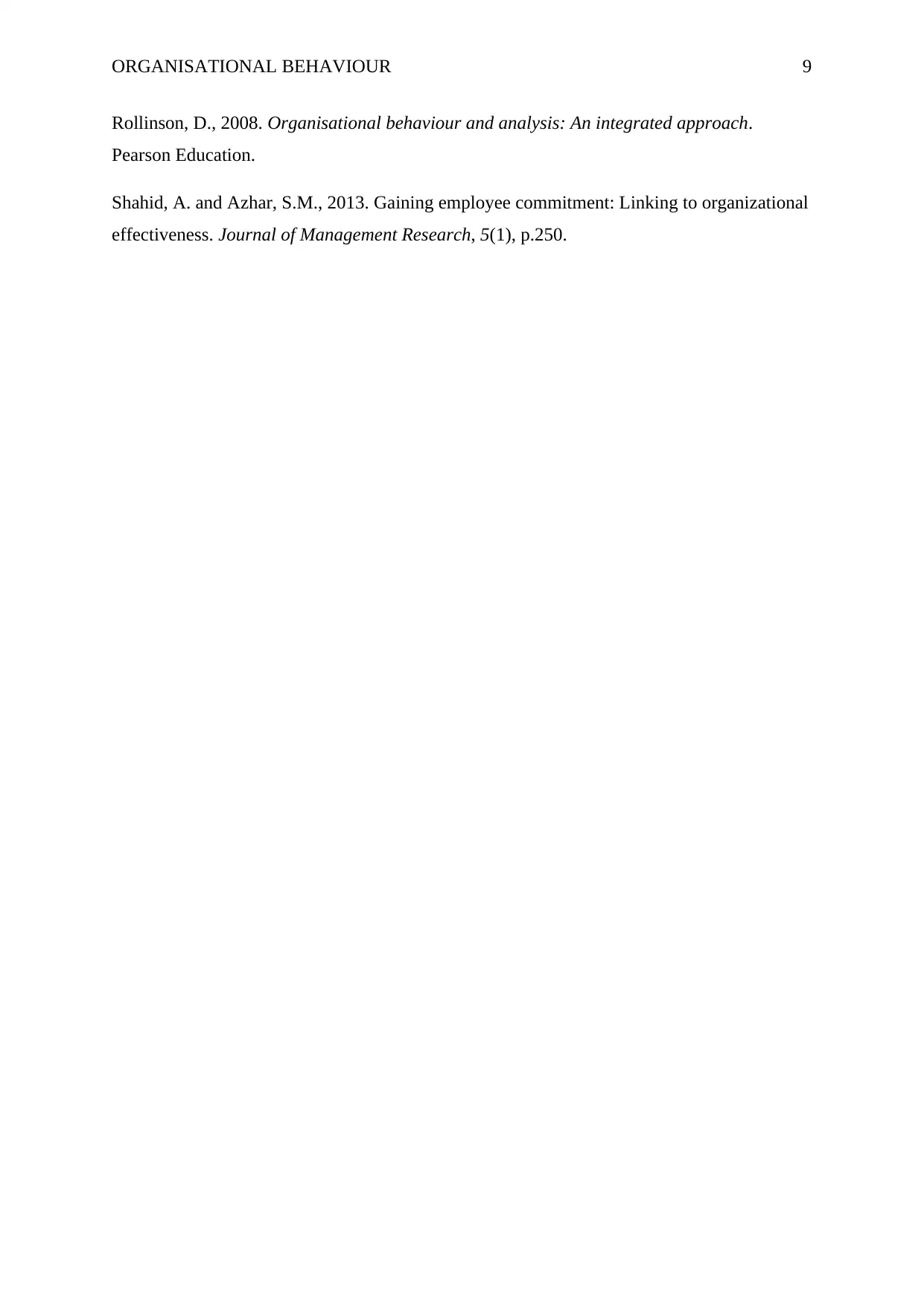
ORGANISATIONAL BEHAVIOUR 9
Rollinson, D., 2008. Organisational behaviour and analysis: An integrated approach.
Pearson Education.
Shahid, A. and Azhar, S.M., 2013. Gaining employee commitment: Linking to organizational
effectiveness. Journal of Management Research, 5(1), p.250.
Rollinson, D., 2008. Organisational behaviour and analysis: An integrated approach.
Pearson Education.
Shahid, A. and Azhar, S.M., 2013. Gaining employee commitment: Linking to organizational
effectiveness. Journal of Management Research, 5(1), p.250.
1 out of 10
Related Documents
Your All-in-One AI-Powered Toolkit for Academic Success.
+13062052269
info@desklib.com
Available 24*7 on WhatsApp / Email
![[object Object]](/_next/static/media/star-bottom.7253800d.svg)
Unlock your academic potential
Copyright © 2020–2025 A2Z Services. All Rights Reserved. Developed and managed by ZUCOL.





